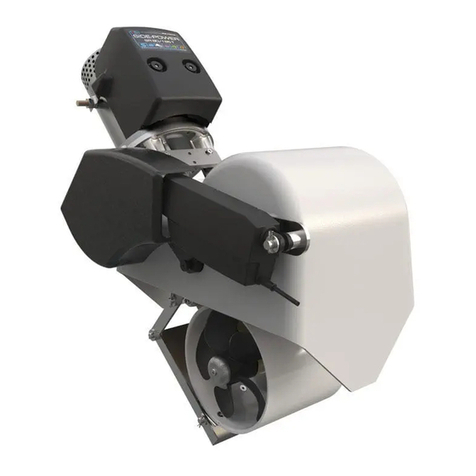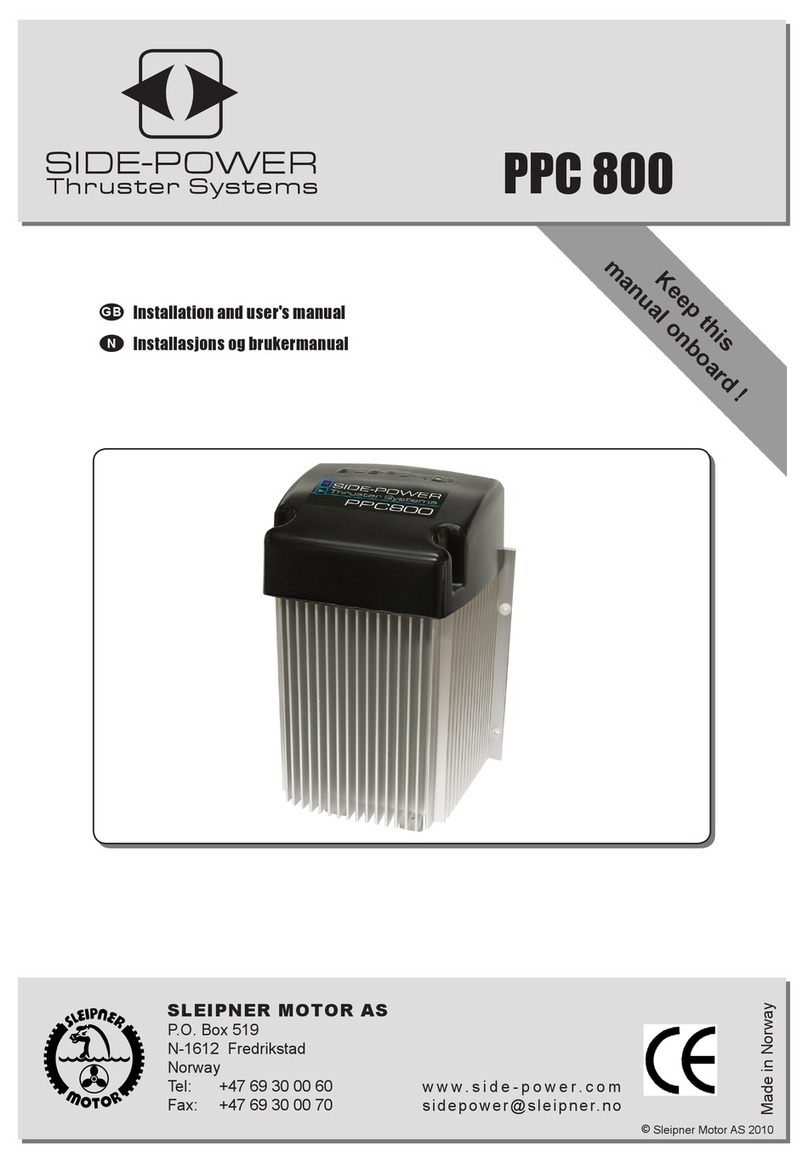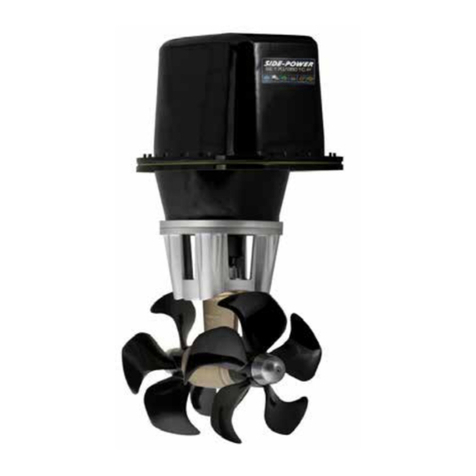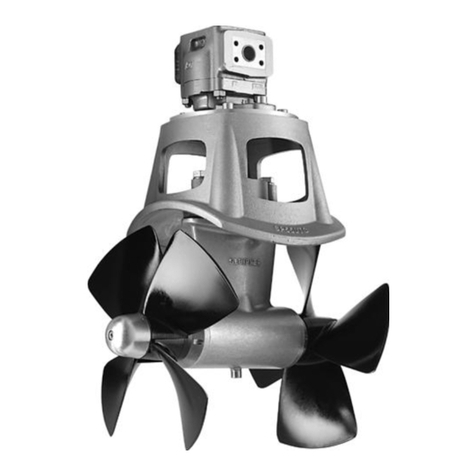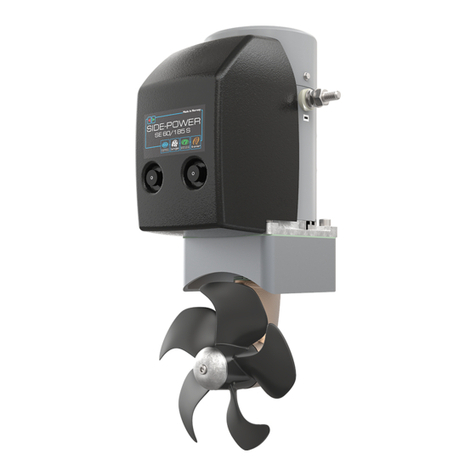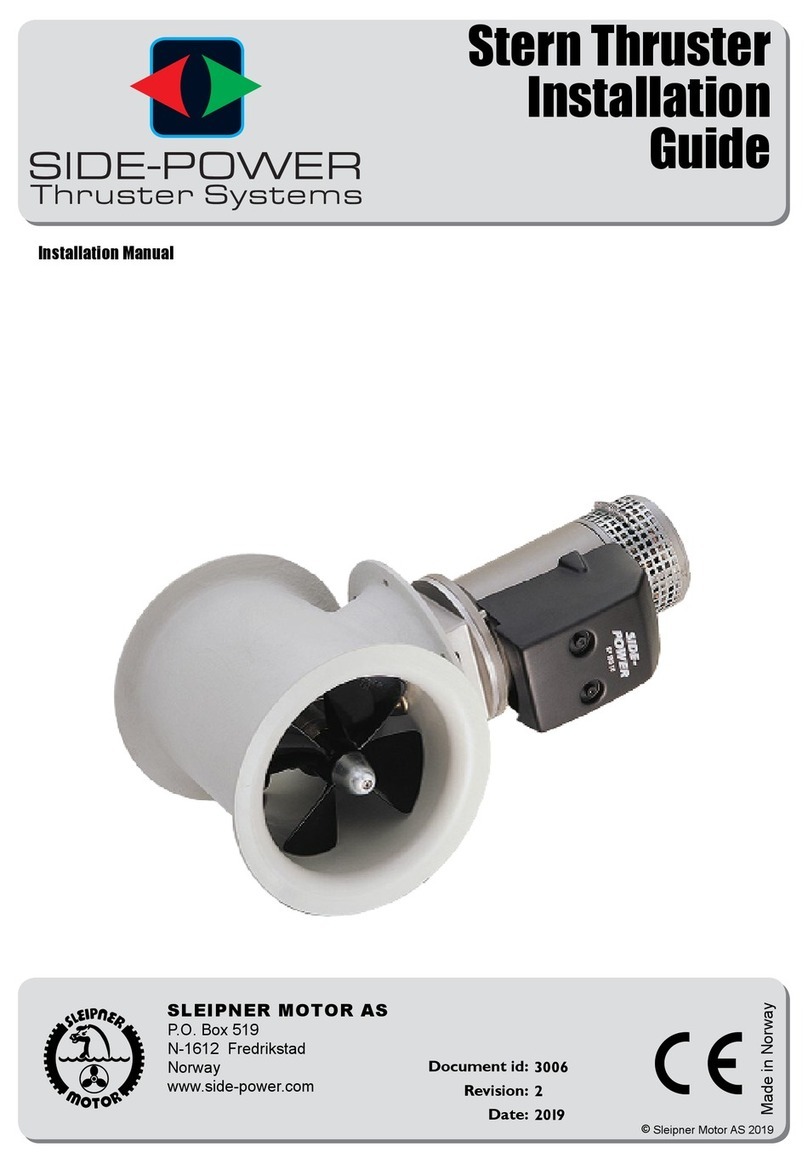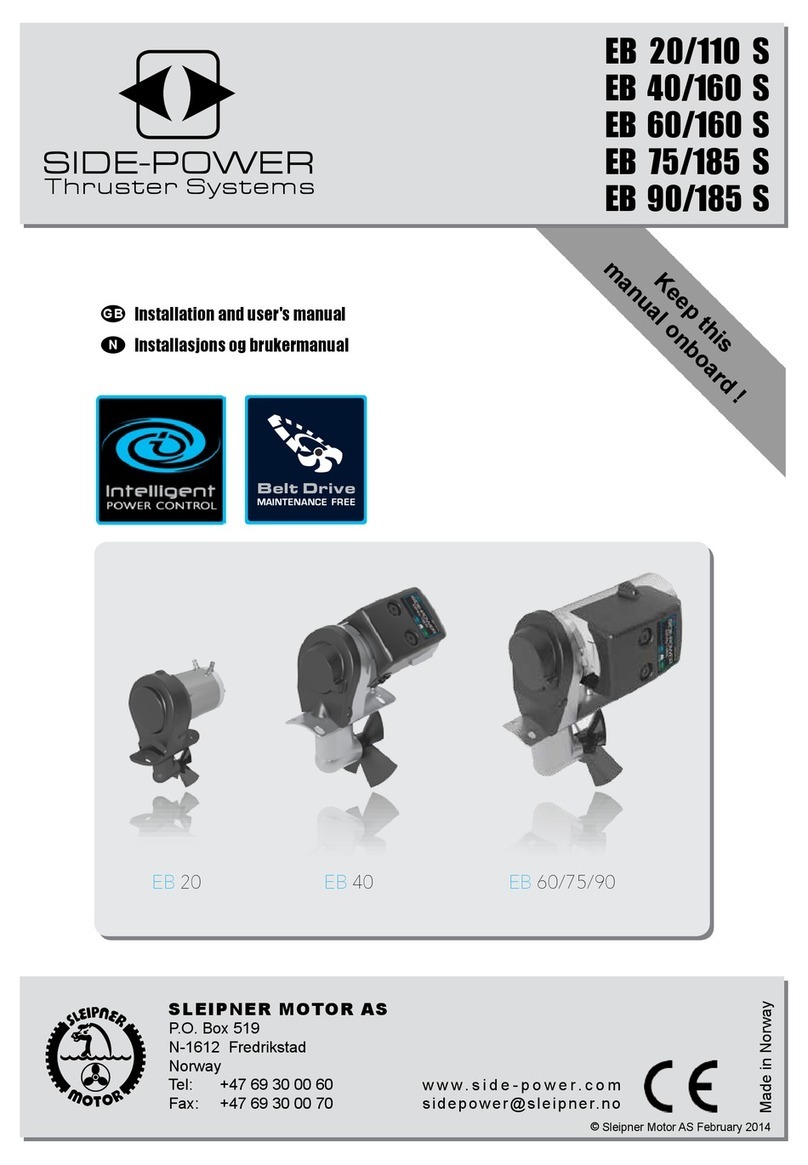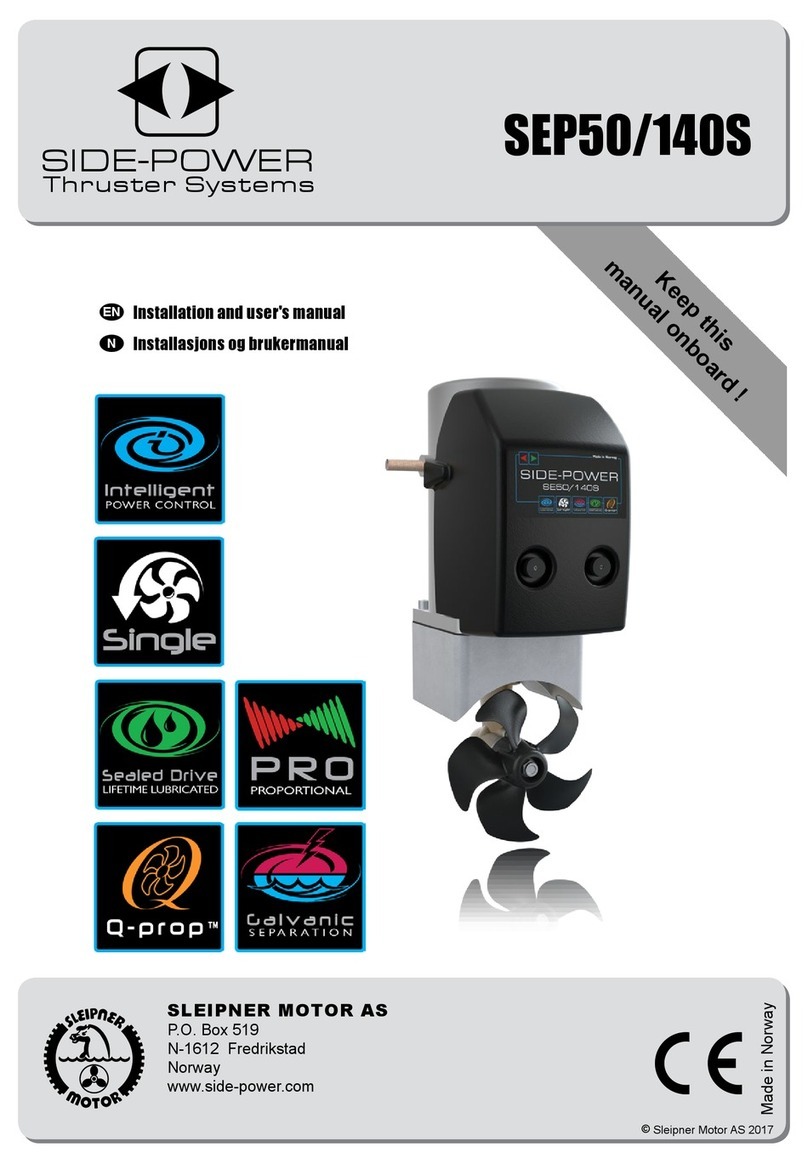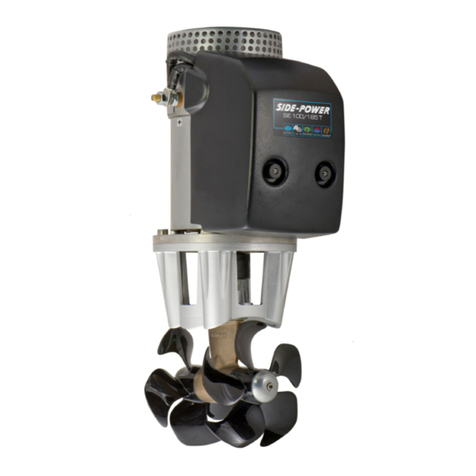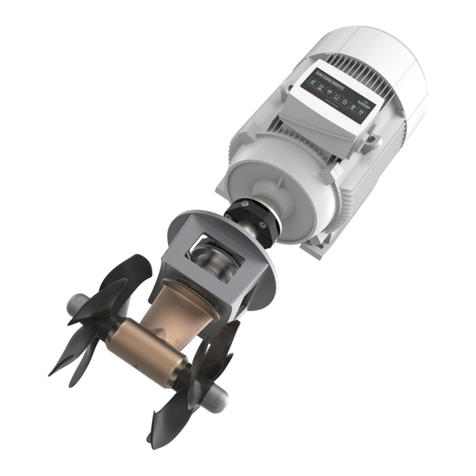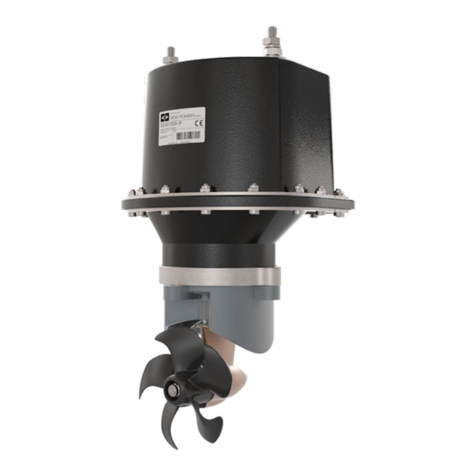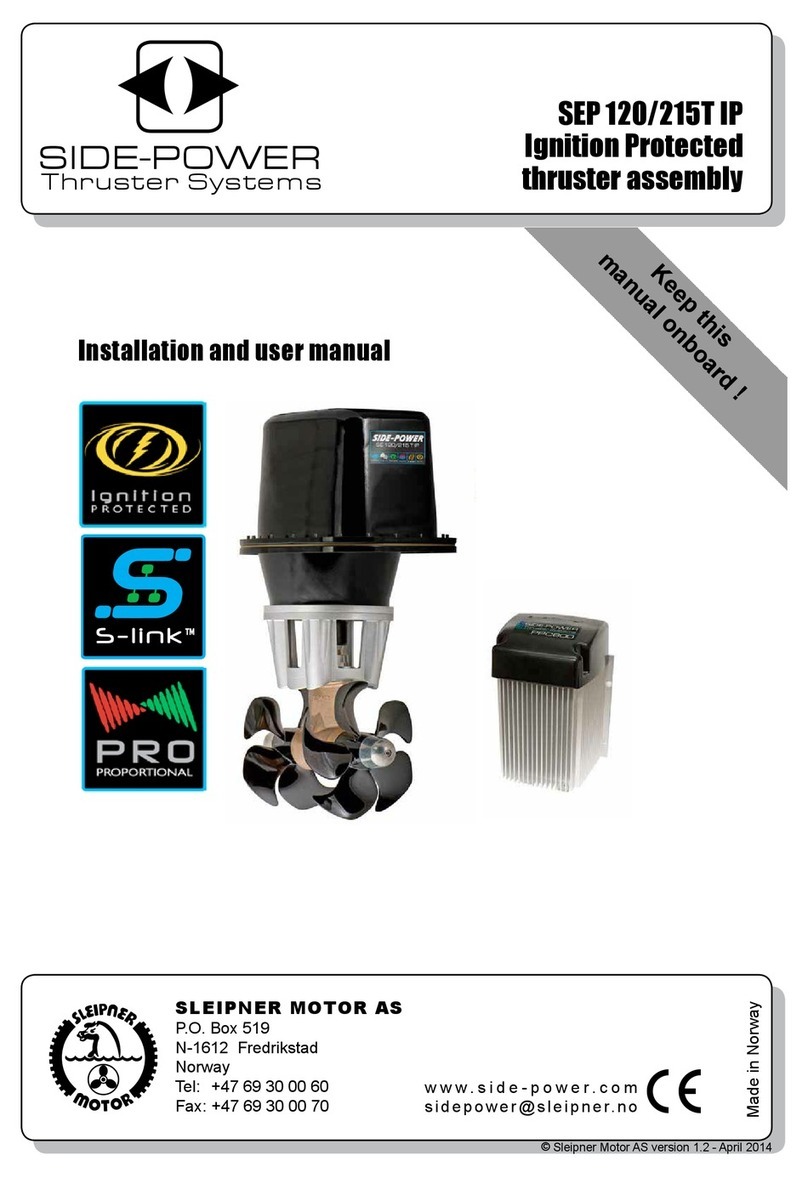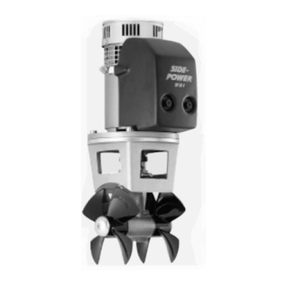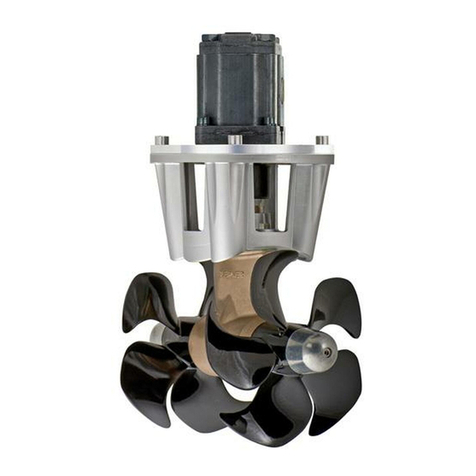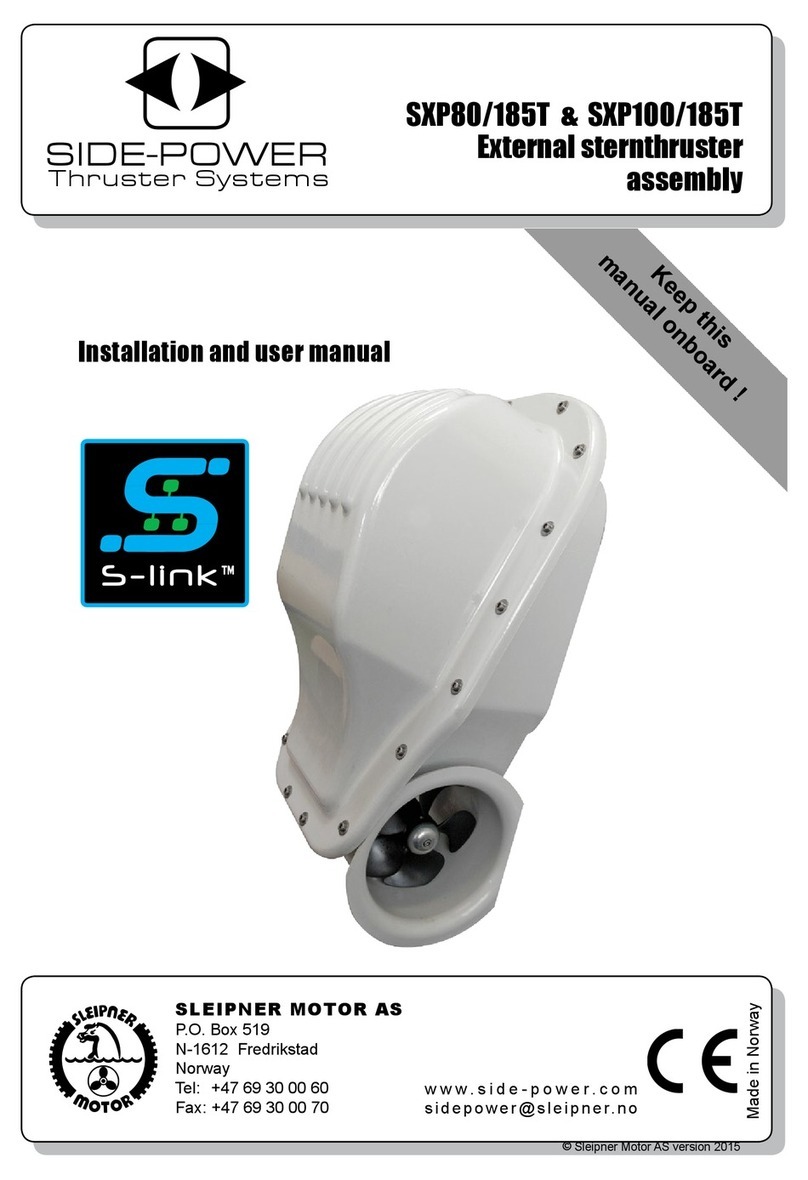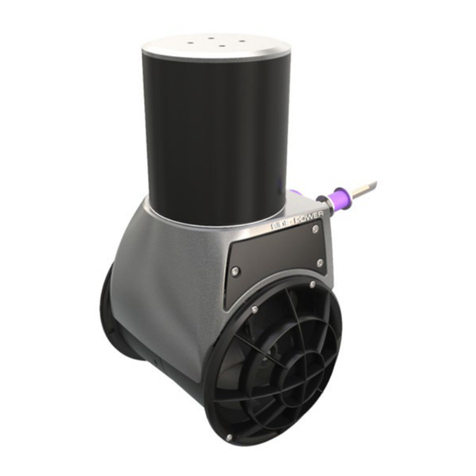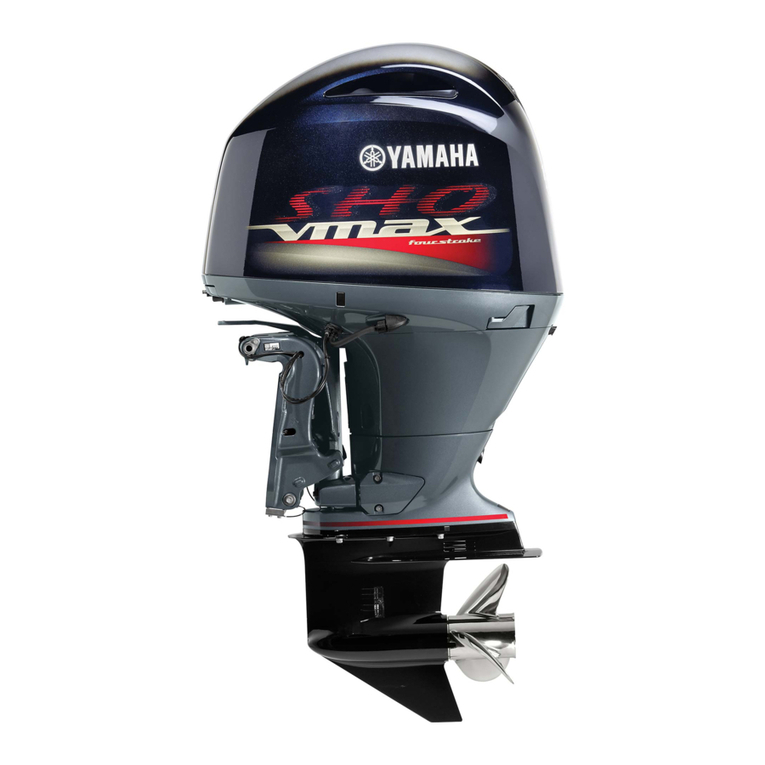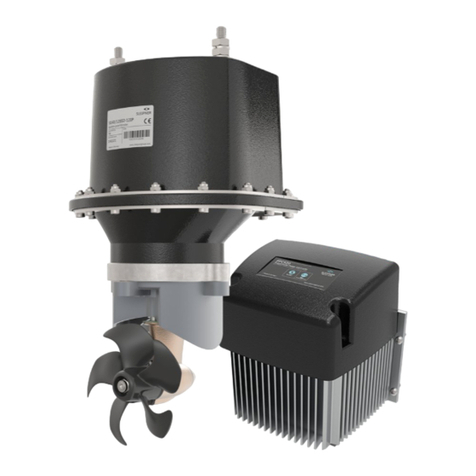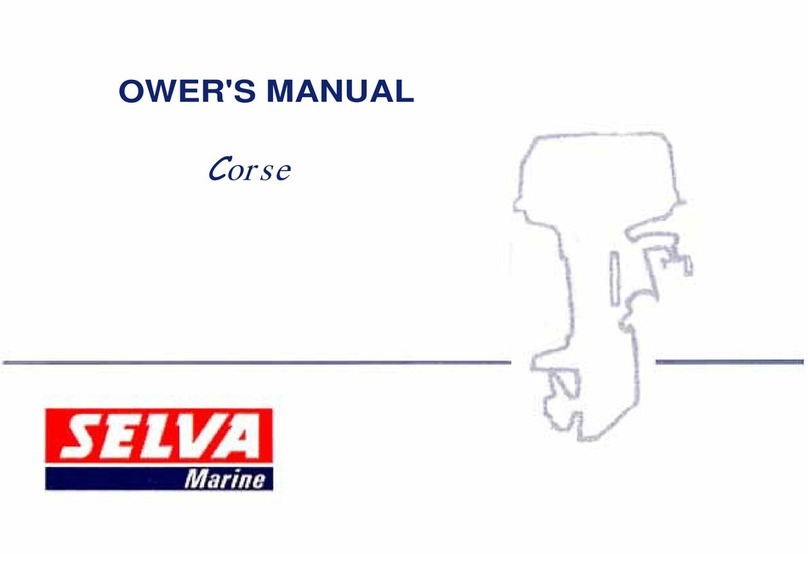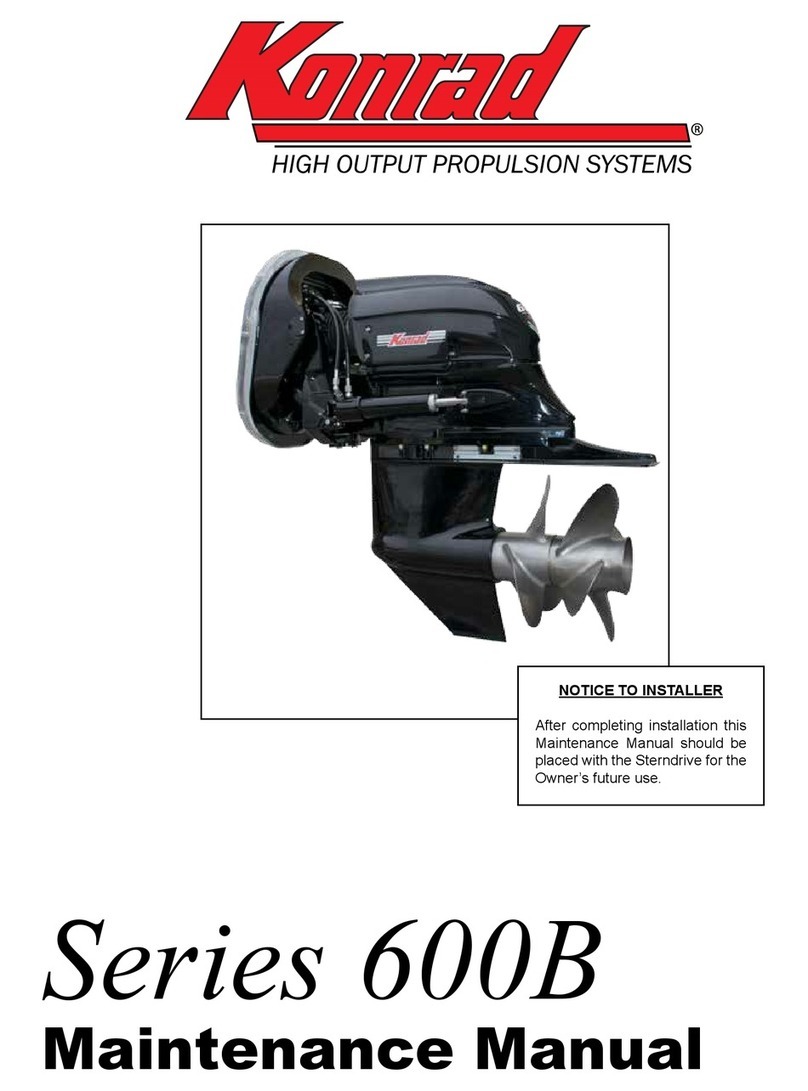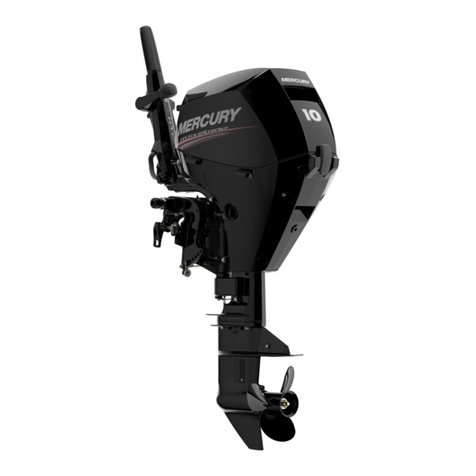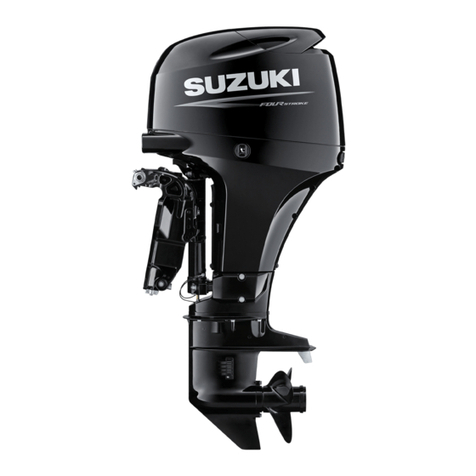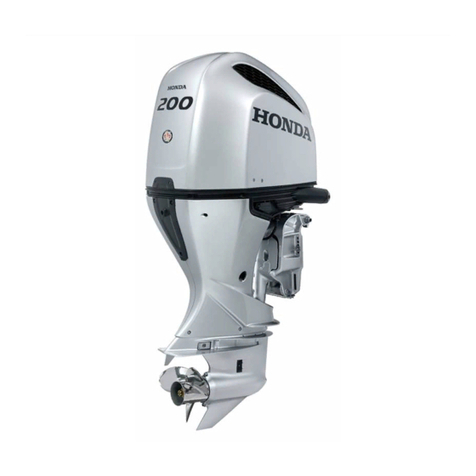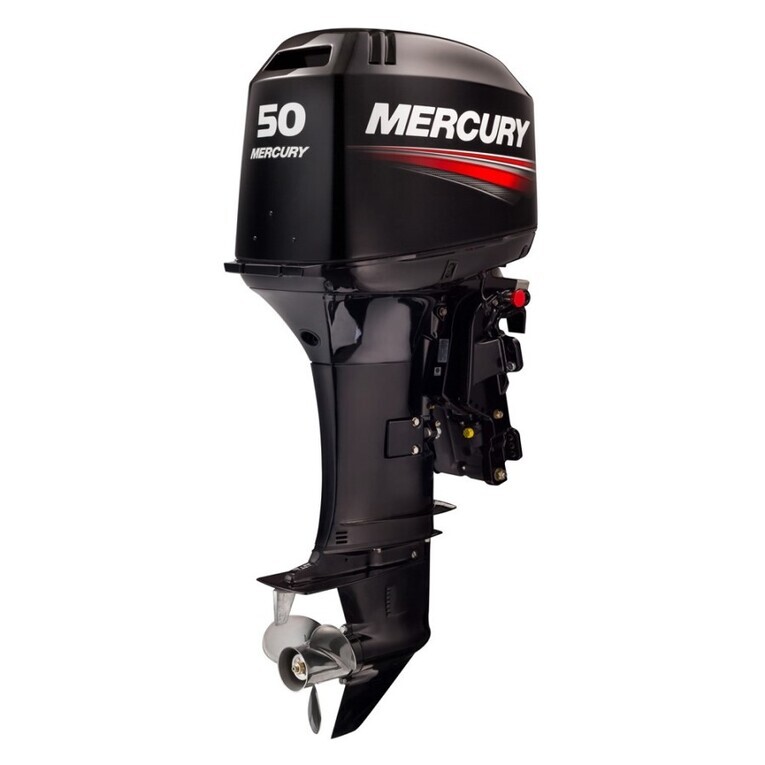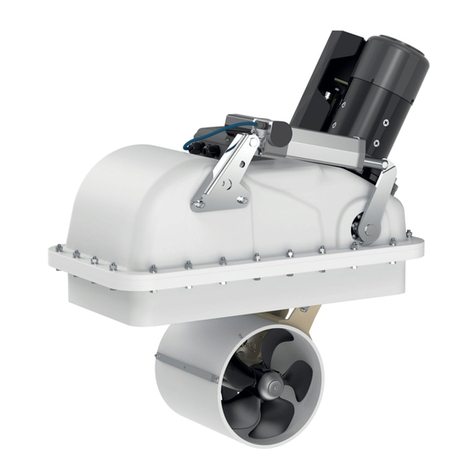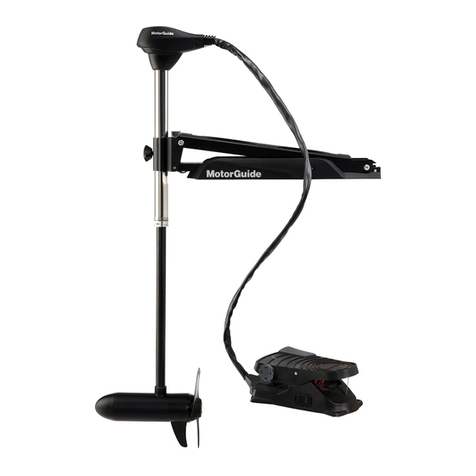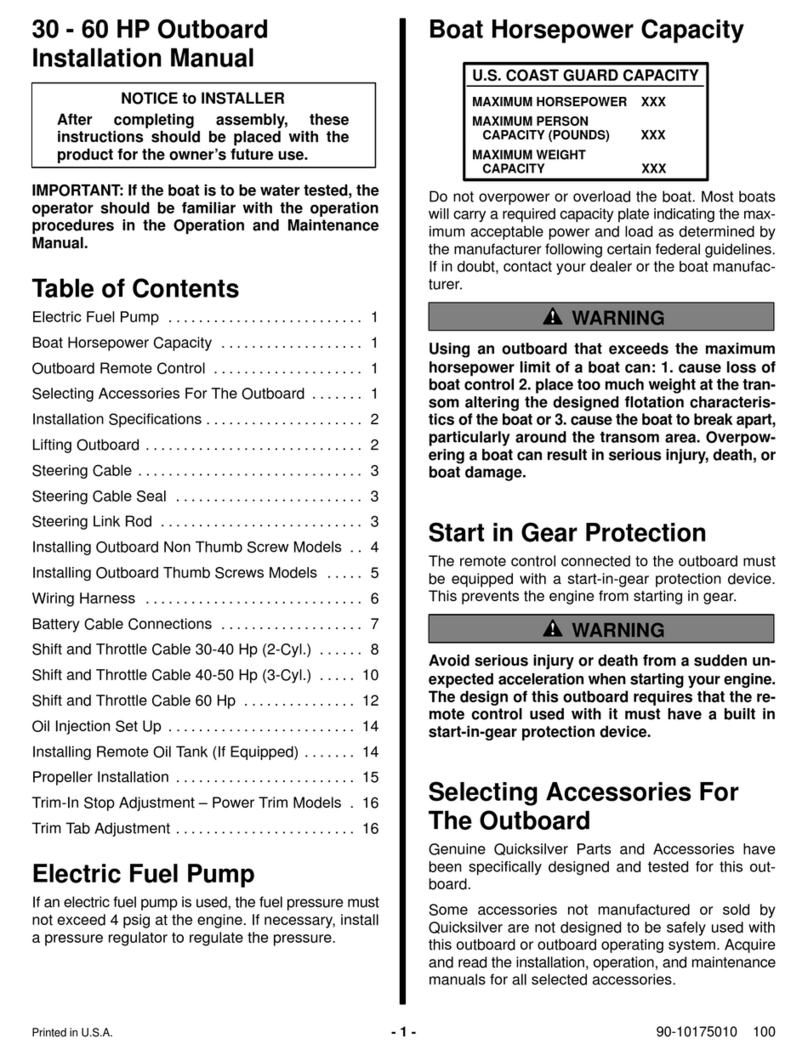3
SEP120/215T - SEP150/215T 1.0.0-2010
Motor: Spesialutviklet reversibel DC-motor.
Girhus: Sjøvannsbestandig bronsje. Kulelagre på pro-
pellaksel. Kule og glidelager komb. på drivaksel.
Motorbraket: Sjøvannsbestandig aluminium.
Galvanisk isolert fra motor
Tunnel: Kryssvevet glassber.
Aluminium og ståltunnel på forespørsel.
Propell: 5-blads skewback "Q-prop" propell i kompositt-
materiale.
Batterier: Minimum anbefalt batteri størrelse.
(Kaldstart kapasitet etter DIN std.)
SEP120/215T 24V: 400 CCA DIN
SEP150/215T 24V: 450 CCA DIN
Driftstid: Opp til kontinuerlig drift avhengig av belastning.
Gjenværende kjøretid vises på kontrollpanelet.
Sikkerhet: Elektronisk tidsforsinkelse forhindrer motorskade
ved rask retningsendring.
Motoren stanser automatisk ved overopphetning
(slår seg automatisk på etter nedkjøling).
Fleksibel kobling mellom drivaksel og motor
beskytter gir hvis propell blir blokkert.
Panel (type PJC) slår seg automatisk av 5 min.
etter siste gangs betjening.(Fabrikkinnstilling).
Denne max-tid kan justeres opptil 60 min. i trinn
a 5min,eller man kan velge bort tidsbegrensnin-
gen helt og slå av med OFF-tasten.
Effektregulatoren PPC sørger for at motorstrøm-
men er slått av hver gang thruster-releet (ret-
ningsreleet) kobler ut eller inn.Dermed unngås
muligheten for sammenbrenning av relekon-
taktene. Evt feil på thruster-releet gir melding til
panelet og slår av motorstrømmen.
Tekniske spesikasjoner
N
Motor: Custom made reversible DC-motor.
Gearhouse: Seawater resistant bronze. Ball bearing at
propeller shaft and combination of ball bearing
and slide bearing at driveshaft.
Motor bracket: Seawater resistant aluminium,
galvanically isolated from motor
Tunnel: Cross spun with rowing G.R.P tunnel
Steel & aluminium tunnels available at request.
Propeller: 5-blade skewback "Q-prop" propeller, breglass
reinforced composite.
Batteries:
Minimum recommended battery capacity
(cold crank capacity by DIN/SAE standard)
SEP120/215T 24V : 400 CCA DIN/760 CCA SAE
SEP150/215T 24V : 450 CCA DIN/855 CCA SAE
Max. use: Up to continous run time depending on load.
Remaining run time shown on control panel.
Safety
:
Electronic time-lapse device protects against
sudden change of drive direction. Electric thermal
cut-off switch in electro motor protects against
over heating (auto reset when electro motor cools
down).
Flexible coupling between electro motor and
driveshaft protects electro motor and gear
system if propeller gets jammed.
PJC panel shuts of automatically 5 minutes
after last use (factory default). This interval can
be adjusted in 5 min steps up to 60 minutes or
turned off completely
The PPC Speed Control unit will turn off motor
power each time main solenoids is activated.
This removes any possibility for solenoid lock
in. Any fault in the main solenoids will give feed
back to the panel and turn off power to the
electric motor.
Technical specications
GB
SEP 120/215 T SEP 150/215 T
Thrust [lbs] 242 330
A [in] 8,46 8,46
B [in] 15,3 15,7
Cmin. [in] 8,5 8,5
D [in] 11 11
D recommended [in] 22 22
Emin. [in] 0,24 0,24
Emax. [in] 0,31 0,31
Motor output [Hp] 8,55 8,8
Voltage [V] 24 24
Weight [lbs] 74 79
Note: Emin.: wall thickness of a standard Side-Power tunnel
Emax.: maximum wall thickness when using other GRP,
steel or aluminium tunnels
SEP 120/215 SEP 150/215
Thrust [kg] 120 120
A [mm] 215 215
B [mm] 389 398
Cmin. [mm] 215 215
D [mm] 280 280
D recommended [mm] 560 560
Emin. [mm] 6 6
Emax. [mm] 8 8
Motor output [kW] 6,4 6,6
Voltage [V] 24 24
Weight [kg] 34 38
Note: Emin.: wall thickness of a standard Side-Power tunnel
Emax.: maximum wall thickness when using other GRP,
steel or aluminium tunnels
METRIC
IMPERIAL
Motor: Custom made reversible DC-motor.
Gearhouse: Seawater resistant bronze. Ballbearing at
propellershaft and combination of ballbearing
and slide bearing at driveshaft.
Motor bracket: SP 75 Ti / SP 95 Ti / SP 125 Ti:
Seawaterresistant aluminium
Tunnel: Cross spun with rowing G.R.P tunnel
Steel & aluminum tunnels available at request.
Propeller: Symmetrical 4 blade propeller, fibreglass reinforced
composite.
Batteries:
Minimum recommended battery capacity
(cold crank capacity by DIN/SAE standard)
SP75Ti 12V : 550 CCA DIN/1045 CCA SAE
24V : 300 CCA DIN/570 CCA SAE
SP95Ti 12V : 750 CCA DIN/1425 CCA SAE
24V : 400 CCA DIN/760 CCA SAE
SP125Ti 12V : 750 CCA DIN/1425 CCA SAE
24V : 400 CCA DIN/760 CCA SAE
Max. use: S2 = 3 min. or appr. 7-10% within a limited time
frame.
Safety
:
Electronic time-lapse device protects against
sudden change of drive direction. Electric thermal
cut-off switch in electromotor protects against over
heating (auto reset when electro motor cools down).
Flexible coupling between electro-motor and
driveshaft protects electromotor and gearsystem
if propeller gets jammed.
If original Sidepower panel is used, the panel
shuts off automatically 6 minutes after last use.
Integrated microprocessor monitors solenoids,
reducing wear and risk of solenoid lock-in. Auto-
stop of thruster in case of accidental solenoid
lock-in or if run signal is continous for more than
3 minutes
Technical specifications
GB
SP 75 Ti SP 95 Ti SP 125 Ti
Thrust [lbs] 165 209 275
A [in] 7,28 7,28 9,84
B [in] 13,9 15,3 15,7
Cmin. [in] 7,87 7,87 9,0
D [in] 6,7 6,7 11,0
D recommended [in] 13,4 13,4 22,0
Emin. [in] 0,24 0,24 0,28
Emax. [in] 0,31 0,31 0,39
Motor output [Hp] 6 8 8,7
Voltage [V] 12/24 12/24 12/24
Weight [lbs] 44 68 77
Gear oil capacity [fl.oz]2.367 2.367 6,736
Note: Emin.: wall thickness of a standard Sidepower tunnel
Emax.: maximum wall thickness when using other GRP,
steel or aluminium tunnels
SP 75 Ti SP 95 Ti SP 125 Ti
Thrust [kg] 75 95 125
A [mm] 185 185 250
B [mm] 352 389 398
Cmin. [mm] 200 200 230
D [mm] 170 170 280
D recommended [mm] 340 340 560
Emin. [mm] 667
Emax. [mm] 8 8 10
Motor output [kW] 4,4 6 6,5
Voltage [V] 12/24 12/24 12/24
Weight [kg] 20 31 37
Gear oil capacity [ml] 70 70 200
Note: Emin.: wall thickness of a standard Sidepower tunnel
Emax.: maximum wall thickness when using other GRP,
steel or aluminium tunnels
METRICMETRIC
METRICMETRIC
METRIC
IMPERIALIMPERIAL
IMPERIALIMPERIAL
IMPERIAL
Motor: Gleichstrommotor
Getriebegeh.: Seewasserbeständige Bronze. Kugellager an
der Propellerachse, Kombination von Kugel-
und Gleitlager an der Antriebsachse.
Motorhalterung: SP 75 Ti / SP 95 Ti / SP 125 Ti:
Seewasserbeständiges Aluminium
Tunnel: Glasfibertunnel (Kreuzgewebe)
Stahl- & Aluminiumtunnel auf Anfrage.
Propeller: Symmetrischer, 4 flügeliger Kaplanpropeller aus
Glasfiberverbundmaterial.
Batterie:
Empfohlene mind. Batteriekapazität
(Kaltstartkapazität nach DIN/SAE)
SP75Ti 12V : 550 CCA DIN/1045 CCA SAE
24V : 300 CCA DIN/570 CCA SAE
SP95Ti 12V : 750 CCA DIN/1425 CCA SAE
24V : 400 CCA DIN/760 CCA SAE
SP125Ti 12V : 750 CCA DIN/1425 CCA SAE
24V : 400 CCA DIN/760 CCA SAE
Betriebszeit: S2 = 3 min. oder ca. 7-10% innerhalb eines
beliebigen Zeitraumes.
Sicherheit
:
Elektronische Zeitverzögerung zum Schutz des
Getriebes bei plötzlichem Wechsel der Drehrich-
tung. Elektrischer Thermoschalter zum Schutz
des Motors gegen Überhitzung (erneute Betriebs-
bereitschaft nach Abkühlung).
Scherstift zwischen Elektromotor und Getriebe-
achse als Schutz, wenn der Propeller blockiert
ist. Nach der letzten Benutzung schaltet das
Original Side-Power Panel automatisch nach 6
Minuten ab. Der integrierte Mikroprozessor
überwacht das Relais und reduziert sowohl
Verschleiß, als auch Relaisblockade. Das
Bustrahlruder stoppt automatisch bei Relais-
Blockade, oder bei Betrieb des Bugstrahlruders
von mehr als 3 Minuten.

